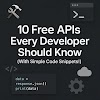YouTube is shaking things up again — and this time, it’s all about originality. Starting July 15, 2025, new monetization rules will go into effect, focusing on authentic, human-created content. If you're a creator who uses automation, AI tools, or repurposed content, this update could change the game for your channel.
Let’s break it all down — so you can protect your earnings and future-proof your content.
🎯 What’s Changing?
YouTube's updated monetization policy will demonetize content that is:
- Mass-produced
- AI-generated without human input
- Repetitive or minimally altered
- Clips from other creators with little value added
If your channel relies on reusing content with minimal transformation (like slideshows, auto-read articles, or reaction videos without commentary), this policy directly affects you.
🧠 Why This Matters to Tech Creators
As developers, many of us build:
- AI workflows
- Tutorial videos
- Auto-generated content (via scripts, APIs, or GPT)
These can be powerful — but they must include your own voice, insights, or on-screen presence to remain eligible for monetization.
🔍 YouTube’s Official Guidance (Paraphrased)
“We do not allow content that is automatically generated or stitched together from third-party sources — unless it adds significant educational or artistic value.”
✅ What This Means:
You can still use automation or AI, but you must layer it with your own creativity. Think voiceovers, commentary, tutorials, or custom edits that demonstrate effort.
📺 Examples of Non-Compliant Content
❌ Text-to-speech articles with no personal context
❌ News compilation with robot narration
❌ Auto-generated quotes/videos/slideshow mashups
❌ Entire podcast episodes uploaded with no edits
✅ Tip: If you're using ChatGPT or Python to generate bulk videos or blog narrations, make sure to edit, narrate, or reframe them meaningfully.
✔️ What Will Still Qualify for Monetization
✅ Original tutorials with your voice or on-screen guidance
✅ Screen-recorded demos with commentary
✅ App builds, live coding, and walkthroughs
✅ AI-generated clips with significant human narration or visuals
🎥 If you're a dev running a tech tutorial channel, you're mostly safe — as long as you're hands-on with your content and not just repurposing existing media.
⚙️ Best Practices to Stay Compliant
- Add value: Every reused clip or idea should be clearly transformed.
- Show your face or voice when possible — or at least provide strong visual commentary.
- Avoid “lazy AI” uploads: GPT-generated content must still reflect YOU.
- Diversify your content types: Mix tutorials, live streams, shorts, and Q&A sessions.
- Disclose your process: Viewers (and YouTube) appreciate transparency.
🚀 SEO + Marketing Angle
Google and YouTube value content that solves user intent. Unique, well-explained tutorials (like coding walkthroughs) rank better and convert more viewers into subscribers. So by staying original, you're not only safe — you're also boosting your discoverability.
✅ Final Thoughts
YouTube’s July 15 update is not a ban on automation or AI — it’s a push for creativity and authenticity. If you’re a tech creator making real educational content, this policy shift could actually help you stand out.
Take a moment to audit your content library. Update older videos, add commentary, and make sure your voice is clearly present.
👉 Got questions about how to stay compliant as a coding or AI-focused creator? Drop a comment or DM us. Let’s navigate this new YouTube era — together.
🌐 Stay Connected with Tech Talker 360
🧠 P.S. If you're interested in building your own YouTube automation workflows using Python or GPT, check out our automation & AI tutorials.












0 Comments